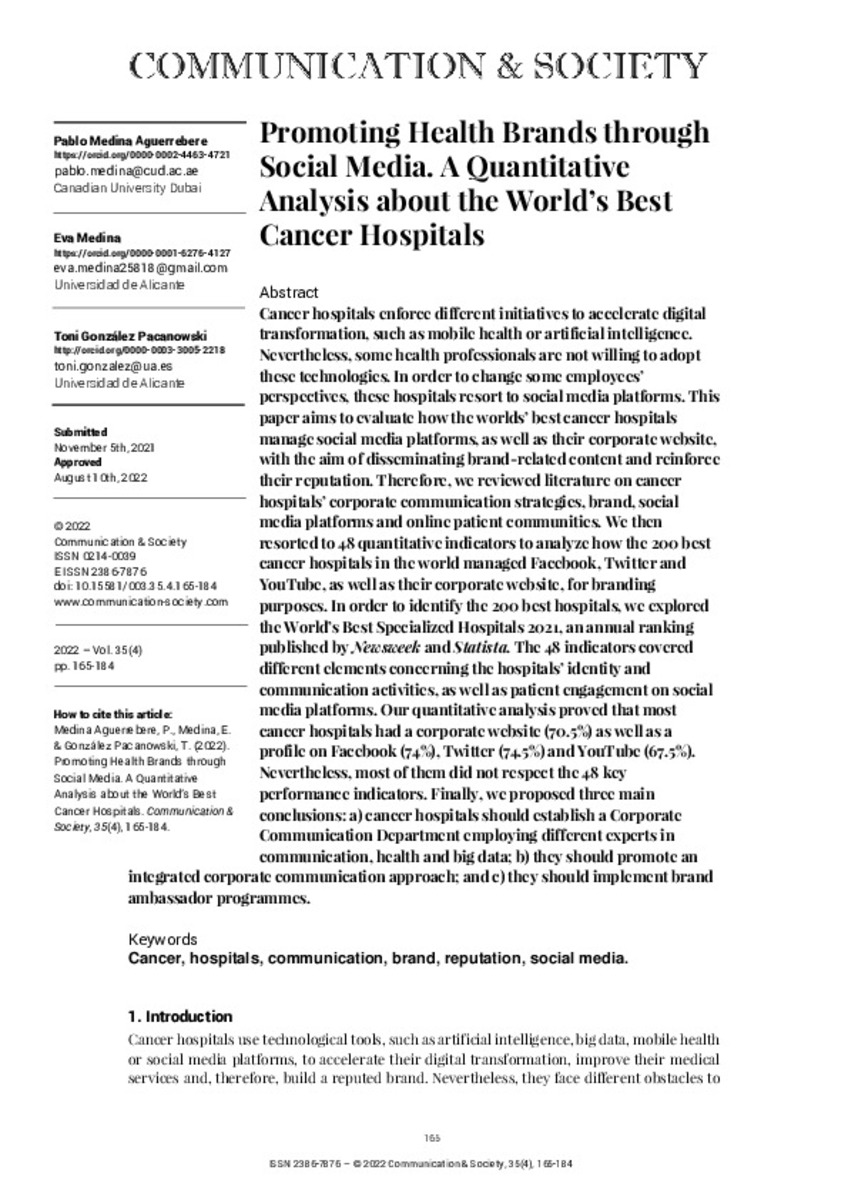Full metadata record
| DC Field | Value | Language |
|---|---|---|
| dc.creator | Medina-Aguerrebere, P. (Pablo) | - |
| dc.creator | Medina, E. (Eva) | - |
| dc.creator | González-Pacanowski, T. (Toni) | - |
| dc.date.accessioned | 2022-10-03 | - |
| dc.date.accessioned | 2022-12-20T14:57:44Z | - |
| dc.date.available | 2022-12-20T14:57:44Z | - |
| dc.date.issued | 2022 | - |
| dc.identifier.citation | Medina-Aguerrebere, P. (Pablo); Medina, E. (Eva); González-Pacanowski, T. (Toni). "Promoting Health Brands through Social Media. A Quantitative Analysis about the World’s Best Cancer Hospitals". Communication & Society. 35 (4), 2022, 165 - 184 | es |
| dc.identifier.issn | 2386-7876 | - |
| dc.identifier.uri | https://hdl.handle.net/10171/64915 | - |
| dc.description.abstract | Cancer hospitals enforce different initiatives to accelerate digital transformation, such as mobile health or artificial intelligence. Nevertheless, some health professionals are not willing to adopt these technologies. In order to change some employees’ perspectives, these hospitals resort to social media platforms. This paper aims to evaluate how the worlds’ best cancer hospitals manage social media platforms, as well as their corporate website, with the aim of disseminating brand-related content and reinforce their reputation. Therefore, we reviewed literature on cancer hospitals’ corporate communication strategies, brand, social media platforms and online patient communities. We then resorted to 48 quantitative indicators to analyze how the 200 best cancer hospitals in the world managed Facebook, Twitter and YouTube, as well as their corporate website, for branding purposes. In order to identify the 200 best hospitals, we explored the World’s Best Specialized Hospitals 2021, an annual ranking published by <em>Newsweek</em> and <em>Statista</em>. The 48 indicators covered different elements concerning the hospitals’ identity and communication activities, as well as patient engagement on social media platforms. Our quantitative analysis proved that most cancer hospitals had a corporate website (70.5%) as well as a profile on Facebook (74%), Twitter (74.5%) and YouTube (67.5%). Nevertheless, most of them did not respect the 48 key performance indicators. Finally, we proposed three main conclusions: a) cancer hospitals should establish a Corporate Communication Department employing different experts in communication, health and big data; b) they should promote an integrated corporate communication approach; and c) they should implement brand ambassador programmes. | en_US |
| dc.language.iso | eng | - |
| dc.publisher | Servicio de Publicaciones de la Universidad de Navarra | es_ES |
| dc.rights | info:eu-repo/semantics/openAccess | es_ES |
| dc.title | Promoting Health Brands through Social Media. A Quantitative Analysis about the World’s Best Cancer Hospitals | en_US |
| dc.type | info:eu-repo/semantics/article | es_ES |
| dc.identifier.doi | 10.15581/003.35.4.165-184 | - |
| dadun.citation.endingPage | 184 | - |
| dadun.citation.number | 4 | - |
| dadun.citation.publicationName | Communication & Society | - |
| dadun.citation.startingPage | 165 | - |
| dadun.citation.volume | 35 | - |
Files in This Item:
Statistics and impact
Items in Dadun are protected by copyright, with all rights reserved, unless otherwise indicated.






